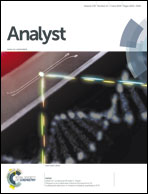Visualizing mass transport in desorption electrospray ionization using time-of-flight secondary ion mass spectrometry†
Abstract
Time-of-flight secondary ion mass spectrometry (ToF-SIMS) was used to determine the effect of ambient probe incidence angle on the amount and direction of analyte molecules transported from the sample surface for desorption electrospray ionization (DESI). Incidence angle was critical to both the lateral dispersion and vertical take-off angles of analyte molecules desorbed from the surface; as the incidence angle was increased from 30° to 45° to 60° (relative to the sample surface), the lateral dispersion angle decreased from 79° to 71° to 62°, respectively, while the vertical take-off angle decreased dramatically from 12° to 6° to 4°, respectively. As for the amount of material transported, the ToF-SIMS normalized secondary ion intensity of the molecular ion (peak counts per total spectrum counts) showed a significant decrease in the signal when the incidence angle was made steeper, decreasing from 8.1 × 10−3 to 4.2 × 10−3 to 7.5 × 10−4, respectively. The ambient mass spectrometer interfaced with DESI also showed a similar analyte response, where the intensity of the molecular ion decreased from 1.6 × 107 counts to 3.3 × 106 counts to 5.4 × 105 counts, respectively. Overall, a steeper incidence angle was characterized by smaller amount of material desorption and tighter dispersion in both lateral and vertical directions. The study showed how ToF-SIMS can be used as a unique tool for characterizing the transport of desorbed analyte molecules in ambient ionization mass spectrometry, potentially offering new interface designs for optimal analyte collection.


 Please wait while we load your content...
Please wait while we load your content...